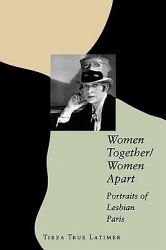 Women Together / Women Apart: Portraits of Lesbian Paris
Women Together / Women Apart: Portraits of Lesbian Paris
by Tirza True Latimer
Ruthers University Press. 144 pages, $24.95
MANY LESBIAN READERS are familiar with the discernible lesbian presence in Paris during the long weekend between World War I and World War II. We know it by their presence at the Shakespeare and Company bookstore and at Gertrude Stein’s salon. We know it through literature and biography. We may have seen photographs of these women, but most of us haven’t considered what these photos actually mean. Today we tend to take lesbian images for granted. While k d lang, Ellen DeGeneres, and Melissa Etheridge are visible lesbian icons, there is no uniformity to the lesbian image because, unfortunately, lesbians are still held up next to straight women rather than next to other lesbians to construct categories of normal. Tiraz True Latimer’s Women Together / Women Apart doesn’t make this mistake.






